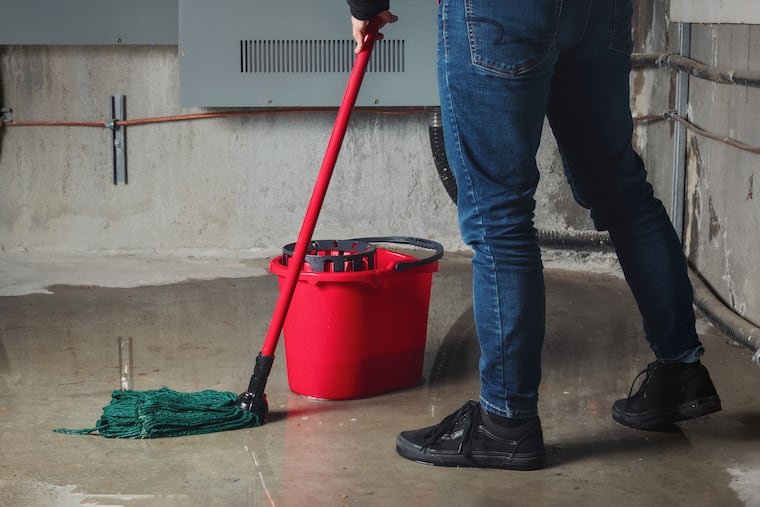How to keep your basement dry
April showers may bring May flowers but they can also cause wet basements.

April showers may bring May flowers, but they can also cause wet basements. Before paying a basement waterproofing contractor to fix your soggy situation, consider some more affordable fixes. Many companies will propose installation of expensive interior drainage systems — even if you don’t need them — when most moisture problems can be solved in better, less expensive ways.
Upgrade gutters and downspouts
Basements usually get wet when rainwater runs toward the walls of houses from roofs, yards and driveways. You need to force this water away from your home, not to collect it once it’s inside and pump it out, which is what most contractors will propose.
Start by checking and fixing your gutters. Clean them out, patch any holes, and make sure they slope toward downspouts and have not come loose from the house, allowing water to fall directly from the roof to the ground next to walls. Test gutter downspouts to make sure they spill water at least four feet away from the house.
You can extend downspouts for less than $15 each; gutter repairs are more expensive. But these improvements are worth the price, even if they do not fully solve your water problem.
Regrade soil
The next step is to inspect the soil around your house and regrade it, if necessary. This is a job you can do yourself, or you can call in a landscaper. The earth around your house should slope at least one inch per foot going away from your house for about six to eight feet out from the house. The grading should consist of fill soil with a clay content of 20% to 30%. Don’t use sandy soil or soil containing a lot of organic matter; it will not shed water adequately.
Before adding dirt around your foundation, rake out all old mulch, leaves and ground cover. If they are filled over, they will create a shelf that catches water.
A grading solution obviously has important advantages. It costs little — dirt, after all, is cheap — requires no great skill and should move enough water away from your house to prevent serious harm.
If portions of your yard slope toward your house, you may have to cut a shallow ditch — or swale — to divert water before it reaches the house. A swale is a U-shaped, shallow ditch dug perpendicular to the water flow. Like regrading, it’s a fairly simple job.
Regrading or diverting surface water will solve most basement moisture problems, but it may not always be the best approach. It may cost more than other solutions — for instance, if you have to rebuild an elaborate patio that slants toward your house, or if you have to redo extensive landscaping in the problem area. Furthermore, grading is not a sure cure for leakage problems; water may be penetrating your basement from places that originate well away from your house. Finally, sometimes regrading is a relatively frail solution; a little careless digging in your garden may produce a new source of leakage just after you have installed a home theater in your basement.
Waterproof walls
If regrading and other surface drainage improvements don’t solve the problem, more drastic — and expensive — solutions await.
For most homes, the next best approach is to waterproof walls from the outside. To do this, a trench is dug to the depth of the footings of affected walls. A drainage pipe is installed at the bottom of the trench to collect water that seeps from above and carries it to a part of your yard away from your home or into a pit. The exterior walls are covered in plaster and a vapor barrier added. The trench is filled with soil that is tamped down, and the surface area is regraded to improve surface drainage.
Excavating and waterproofing from the outside might be more expensive than installing an interior drainage system. But unlike interior systems, this will actually solve the underlying problem by diverting water away from walls, rather than simply managing water that enters the home.
If you need a hire a contractor
Meet with and obtain proposals from several of them. Some landscaping companies specialize in drainage work. You can get some insight into a company’s performance by checking the ratings and comments posted by area consumers at Checkbook.org. Through special arrangement with the Inquirer, readers can access ratings of basement waterproofing companies free until May 5 via Checkbook.org/Inquirer/Wet-Basement.
Big differences exist in the quality of advice provided by basement waterproofing contractors. Checkbook’s undercover shoppers found that different companies may propose drastically different — and in some cases costly and unnecessary — solutions. Don’t let them pressure you into a decision; avoid companies that use aggressive sales tactics. Compare the guarantees offered by companies that bid on the work.
If your home was built or remodeled within the last few years, check the builder’s warranty for clauses on seepage. The builder might bear the costs of any solutions and repairs.
Delaware Valley Consumers’ Checkbook magazine and Checkbook.org is a nonprofit organization with a mission to help consumers get the best service and lowest prices. It is supported by consumers and take no money from the service providers it evaluates.